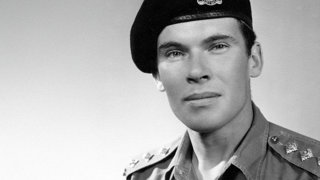Lieutenant Colonel Guy ‘Phillip’ Graham Robinson, who has died aged 84, was one of the most experienced and resourceful Military Survey Officers of his generation, a man whose career traversed continents, climates, and cartographic revolutions - from paper, compass and theodolote to the dawn of the digital age.
Practical, inventive, and quietly courageous, he dedicated over three decades to mapping the world for the British Army, UK and allied governments, combining a soldier’s grit with the curiosity of an explorer.
Known as Guy to his family, Phillip to friends and colleagues and affectionately as GPG or GPGR by the soldiers he served alongside, he embodied the Royal Engineers’ motto Ubique -everywhere. His postings stretched from the jungles of Sarawak to the highlands of Oman, and from the muddy gullies of Aden to a Green Goddess fire engine in Hampshire.
Born in 1940 in the hill station of Murree in what was then British India, son of a British Indian Army Royal Engineer, Phillip was destined to serve. He entered the Army through Welbeck and graduated from the Royal Military Academy Sandhurst in 1960. He ranked sixth in the Order of Merit, and was awarded prizes in tactical and military historical studies, an early sign of the blend of intellectual acuity and operational competence that would define his career.
In the late 1960s, following the intense sixteen-month Army Survey Course, Phillip was posted to Singapore, where he commanded 84 Squadron and led field surveys across Malaya and Sarawak. He relished the challenges of remote, unmapped territories.
In one memorable episode, he was dropped into the Malaysian jungle by helicopter, only to be stranded for several days due to adverse weather. Most would panic, but Phillip, unperturbed, set about his tasks—alone, resourceful, and undeterred—until rescued days later. These were the deeds of a man whose personal resilience matched his professional commitment.
Survey missions took him across continents: Northern Kenya, Cyprus, Oman, and Southern Arabia. Notably, in 1965, aged just 25, he became one of the Royal Geographical Society’s youngest-ever Fellow after earning the prestigious Cuthbert Peek Award for his significant contribution to geographical exploration in southern Arabia.
His work with the Society did not stop there, Phillip joined the Musandam Expedition of 1971/72, led by geologist Norman L. Falcon, it was notable for being one of the first comprehensive scientific explorations of the Musandam Peninsula in Oman. It was multidisciplinary, involving geologists, biologists, archaeologists, ethnographers, and surveyors. Their collaborative efforts resulted in several important publications detailing the region’s geology, biodiversity, and cultural heritage.
After a short stint in the British Forces of Germany during the Cold War, he returned to the UK to command 19 Topographic Squadron (1977–1979) in Barton Stacey, Phillip led geodetic, field, and aerial survey deployments across the Middle East, East Africa, Europe, and Northern Ireland. It was a time of both technical and geopolitical complexity, and Phillip ensured the Squadron operated with agility, professionalism, and spirit.
As an Ordnance Survey Regional Director (1980–1983), based in Edinburgh, he oversaw UK mapping with a civilian-military team of 140, supported the Scottish Boundary Commission, and helped lay groundwork for land registration. His work cemented his reputation as a senior figure who straddled both military and civil spheres of survey.
Returning to military life in 1983 as second-in-command of 42 Survey Engineer Regiment, he brought characteristic innovation to field exercises. Gone were the tired routines of "advance to contact" drills with smoke grenades; in came casualty evacuations under live scenario conditions, and rapid-response operations that trained soldiers for real-world contingencies.
From 1986 to 1989, Phillip stepped fully into the future as the Ministry of Defence’s Terrain Analysis Officer. Despite being a self-proclaimed analogue surveyor, he embraced the digital revolution sweeping through military cartography. His adaptability and foresight smoothed the Army’s transition from traditional mapping to advanced Geographic Information Systems (GIS), and he mentored a new generation of officers through this change.
His final military chapter came in Oman, where from 1989 to 1994 he served as Deputy Director of the National Survey Authority. There, he advised on policy, mapped vast stretches of under-charted territory, and authored a strategic “Way Ahead” plan for Omani mapping infrastructure. With the onset of ‘Omanisation’ in 1994, he stayed on briefly as Special Project Officer to the Chief of Staff of the Sultan’s Armed Forces before finally stepping back from military surveying.
Phillip was a keen sailor throughout his career, skippering many a trip and participated in several Fastnet Races and a circumnavigation of the British Isles. In the 1987 Fastnet Race, Phillip skippered Ilex of Upnor a year after he had suffered a heart-attack. With an all-first-timer crew (including a doctor – a sensible precaution) Ilex endured calms, unexpected squalls, equipment failures, and a close call with rocks in thick fog.
Faulty navigation gear led to significant need to dead reckoning, and at one point a broken main halyard required a daring mast ascent in rough seas. Despite these challenges—including a final comical throttle malfunction—Ilex completed the 740Nm course unaided in 5 days; they didn’t win, but they embodied Sapper spirit throughout.
Phillip’s other keen past-time was potholing and caving; one of his more hair-raising escapades came during a multi-day cave survey in County Fermanagh, deep underground and far from daylight, an underground river began to rise ominously. Phillip and his companion, Andrew Birt, hastily packed their gear - including theodolites, maps, and an inflatable dinghy - only to find the lake they had crossed earlier on the trip was now perilously high.
Forced to deflate the dinghy and lie flat on their backs inside, they inched their way beneath a jagged, low ceiling, using their feet to propel themselves forward. A misjudged bump left the dinghy punctured and sinking, prompting a frantic paddle to safety. They made it, but the ordeal wasn’t over yet.
On the journey out, Phillip’s companion became wedged in a narrowing crawlspace after dislodging a boulder. Calmly, Phillip pressed on alone, looping back through another passage to rescue him from behind. Days after they had begun they emerged - sore, soaked, but victorious. The cave’s newest passage was later named Birt’s Crawl by The British Association, immortalising the ordeal with humour and affection.
The story reflects Phillip’s blend of courage, quick thinking, and unflappable good humour—qualities that marked not just his adventures underground, but the life he led above it.
After retiring from the Army and his subsequent work in Oman, Phillip embarked on what became a remarkable second career, rooted in his deep fascination with First World War military mining and tunnelling. His encyclopaedic knowledge, tireless dedication, and infectious enthusiasm transformed this niche interest into a profound and lasting legacy.
His involvement began with efforts to investigate and make safe the still-charged Durand Mine at Vimy Ridge in 1988, leading to extensive collaboration with Veterans Affairs Canada. In 1997, Phillip spearheaded a pivotal excavation of the Broadmarsh Mine, catalysing the founding of the Durand Group – a specialist team dedicated to the exploration and preservation of military underground systems.
A skilled communicator, Phillip appeared in numerous documentaries and co-authored publications that brought the hidden world of wartime tunnelling to a broader audience. His practical problem-solving, unfailing generosity, and good-humoured leadership earned him the admiration of peers across disciplines. He was the Group’s meticulous archivist, a mentor, and a tireless advocate for remembrance and education.
Phillip remained active with the Durand Group until his death, and his influence is embedded in their every achievement. His commitment ensured that the extraordinary stories of the men beneath the trenches are not forgotten. In the words of one colleague, “To live in the hearts we leave behind is not to die.” Phillip’s legacy endures underground and above – in the preserved tunnels, in the people he inspired, and in the memory of a life devoted to history, friendship, and service.
Phillip Robinson is survived by his family, Alexander – a professor at The University of Birmingham, Jeremy – a fellow Sapper officer – and Mary – a retired nurse and QARANC who he met while based in Singapore.
His was not an ostentatious legacy, but a lasting one: maps that saved lives, systems that shaped futures, and stories that will echo around campfires and reunion halls for many years to come.
Words provided by Jeremy Robinson.

